소개
In the world of movies, venue restrictions have always been a “tightening curse” for creators.
How to break through the constraints of physical space and let creativity fly freely? The emergence of LED 디스플레이 has brought a new solution to filming.
It not only changed the way of shooting but also redefined the possibility of filmmaking. So, how did LED displays break the restrictions on venues and bring revolutionary changes to film creation? Let’s find out.
목차
1. Why is it so important to reduce venue restrictions for filming?
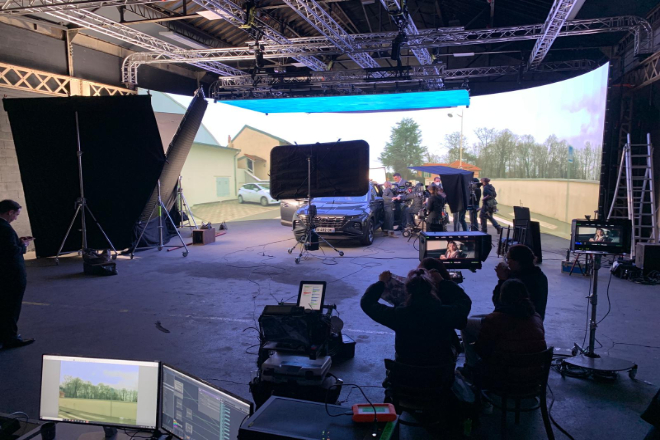
1). Creative freedom
The most feared thing about filming is venue restrictions, which will hold the hands and feet of creators.
For example, if you want to shoot a science fiction film, you want to show outer space and future cities, but there is not enough space.
So you can only make do with ordinary streets or simple studios, and there is no sense of science fiction.
But if there are fewer restrictions on the venue, creators can boldly go to Iceland to shoot or build scenes that meet the story settings, like “Interstellar.”
The venue is flexible, and creativity can also fly, like the planet Pandora in “Avatar,” which is all imagined out of thin air.
With enough venues to choose from, miniature models, special effects, and large studios can all be used to turn the creator’s ideas into images that the audience can see.
2) 비용 관리
With fewer venue restrictions, the cost of the film can be reduced a lot. Venue rental is very expensive.
If you can only choose popular locations or high-end studios, the rent is frighteningly high, and the procedures are cumbersome.
But if the venue selection is flexible, you can choose a cheap place or build a temporary scene yourself, saving a lot of money.
For movies with tight budgets, this money can be spent on actor performances or post-production special effects.
Moreover, flexible venues can also improve shooting efficiency. Frequent transitions waste time and transportation and accommodation costs, but if you concentrate on shooting at a film and television base.
Or, using special effects to synthesize scenes, you can shorten the shooting time, reduce labor and equipment rental costs, and make the budget more reasonable.
3). Artistic presentation
With fewer venue restrictions, the artistic effect of the film can be greatly improved.
From the visual effect point of view, the venue selection is flexible and the picture is more amazing.
For example, when shooting natural scenery films, shooting in places like New Zealand, the sense of reality and beauty far exceeds artificial scenes.
Special effects technology can also be used, such as in the grand scenes of “Avengers,” which are full of visual impact.
At the same time, the right venue can make the story more realistic, and the audience can immerse themselves in it more easily.
For example, war films are shot at real battlefield sites, so the audience can feel the cruelty of war more vividly, and the film will be more appealing.
2. Why are LED screens used in filming sites?
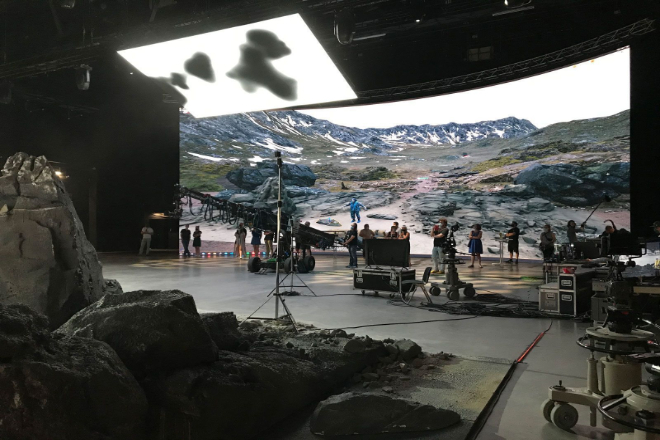
The biggest advantage of LED screens in filming is “what you see is what you get.”
In the past, when filming movies, actors performed in front of green screens, relying entirely on imagination, and directors had to wait for post-production to see the final effect.
This not only makes it easy for actors to get “out of the play” but also time-consuming and laborious post-production.
But with LED screens, actors can directly see the scene they are in when performing.
For example, in “The Mandalorian,” the actors are like they are really standing in an alien world, and their performances are much more natural.
The director can also adjust the scene on the spot and make changes immediately if there is a problem, which greatly improves the efficiency of creation.
Filming is expensive, and time is tight. In the past, in order to shoot different scenes, the crew had to run around or spend a lot of money to build real scenes, which was not only time-consuming but also frighteningly expensive.
But LED display screens are different. They can quickly switch scenes on site.
For example, the LED virtual studio built by Tencent in Shenzhen can handle multiple scenes in one studio without any transitions.
Moreover, most of the effects can be seen during shooting, and the pressure of post-production is much less, which can save a lot of time and cost.
Light and shadow effects are extremely important for movie images, and LED display screens are particularly powerful in this regard.
It can provide real ambient light, reflection, and refraction effects. For example, it is difficult to make the reflection of armor natural with traditional green screens, but LED display screens can easily handle it.
Moreover, its 명도 and color can be adjusted at any time. Whether it is day or night, sunny or rainy, it can perfectly match the shooting needs.
For example, in “The Mandalorian,” those light and shadow effects look very real, and the audience feels more involved after watching it.
The LED display is not only a background screen but also a light source. In the past, when filming, there was a lot of lighting equipment, and the scene was messy.
Now with the LED display, it can provide stable lighting and adjust the light and shadow effects according to the scene changes, making the scene much cleaner.
Moreover, its brightness and color can be adjusted in real-time. For example, when shooting sunrise and sunset, it can be switched in a few minutes, which is very convenient.
No matter what type of movie it is, the LED display can handle it. Science fiction movies can present alien environments and future cities.
In fantasy movies, it can show the magic world and mysterious forests; in action movies, it can quickly switch battle scenes.
For example, in “The Mandalorian,” the alien scenes in it are basically made of LED displays, and the effect is superb.
The same is true for advertising shooting. It can quickly switch the background and highlight the characteristics of the product, which is especially suitable for fast-paced shooting.
Now everyone pays attention to environmental protection, and LED displays are also excellent in this regard.
In the past, when filming, a lot of wood and steel were used to build the real scene, and they were thrown away after use, which was too wasteful.
But LED display screens are different. They can be reused and basically do not use physical materials, which is very friendly to the environment.
Moreover, it has low energy consumption and low carbon emissions, which conforms to the concept of environmental protection.
3. Specific ways in which LED display screens reduce the restrictions on filming locations
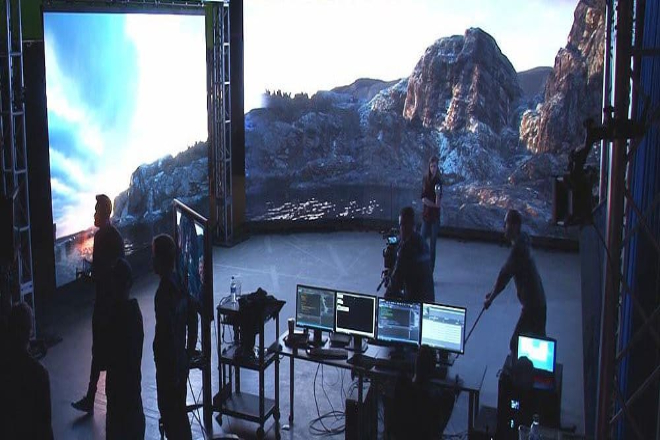
1). Breaking through the limitations of physical space
LED display screens are like the “magic wall” in filming, which can make limited space infinite.
Imagine an ordinary studio with a circle of large LED screens inside, and these screens can become all kinds of super cool backgrounds.
For example, if you want to shoot an alien city or a huge castle, just display it on the screen, and there is no need to really build those complicated buildings.
Just like in “The Mandalorian,” they used a large LED ring screen to “move” the alien world directly into the studio, and the actors performed in it, feeling like they were really there.
This not only saves the venue but also saves time and energy in setting up the scene.
2). Reduce dependence on the natural environment
LED display screens can also “create” various natural environments, so you no longer have to go far away to shoot natural scenery.
For example, if you want to shoot a desert, a forest, or even outer space, just display it on the screen.
This not only saves the travel expenses and time to go to these places, but also does not have to worry about bad weather or the wrong season.
For example, Tencent’s LED studio in Shenzhen can create anything, including deserts, forests, and snow-capped mountains.
You can shoot whatever you want, and you don’t have to worry about the limitations of the natural environment.
3). Fast scene switching and flexibility
LED display screens can switch scenes so fast! In the past, if you wanted to change the scene during filming, you had to spend a long time moving props and adjusting lights, which was very troublesome.
But with LED display screens, you can change the screen image instantly with just a flick of your finger.
For example, when shooting an advertisement, you need a city street for a while and an ancient palace for a while. The LED display screen can do it in a few minutes without having to stop and wait.
This not only saves time but also allows directors and photographers to be more free to play and shoot whatever they want, which is very convenient.
4. What are the optimization steps of an LED display screen for the film shooting process?
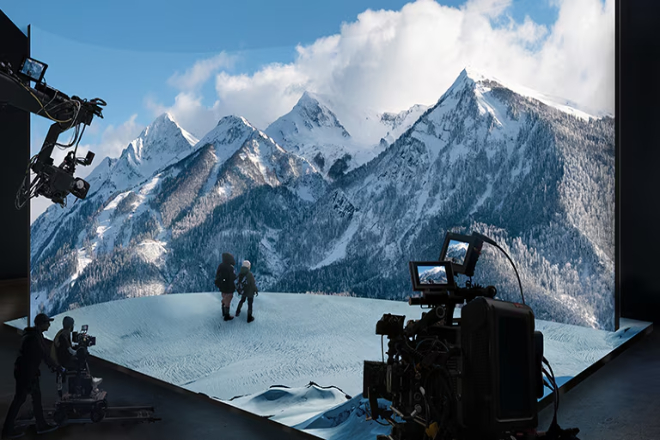
1). Simplification of pre-production preparation
In traditional film shooting, pre-production preparation often requires a lot of time and effort to build scenes, especially complex outdoor scenes or special effects scenes. But with LED display screens, this process can be greatly simplified.
1.1). Reduce the workload of scene construction:
In the past, in order to shoot a scene of the ancient Roman Colosseum, it may be necessary to build a huge real scene, which takes weeks or even months.
Now, with LED display screen technology, as long as a virtual arena background is displayed on the screen, you can start shooting directly.
For example, many scenes of alien planets in “The Mandalorian” are presented through LED display screens, which greatly reduces the need for real scene construction.
1.2). Impact on shooting plan and budget:
Due to the reduction of the need for real-scene construction and outdoor shooting, the time and cost of pre-production preparation are greatly reduced.
What may have taken months of preparation time may now only take a few weeks.
In terms of budget, a lot of construction materials and venue rental costs are saved while reducing the additional costs caused by venue restrictions, making film production more efficient and economical.
2). Real-time feedback during filming
During the filming process, the LED display provides real-time visual feedback to the actors and directors, greatly enhancing the naturalness of the performance and the efficiency of filming.
2.1). Real-time interaction between actors and directors:
The actors can directly see the virtual environment they are in when performing, just like they are really in that scene.
For example, when shooting a horror scene, the LED display can display the gloomy forest background in real time so that the actors can better feel the atmosphere and perform more naturally.
The director can also see the final picture effect in real-time and adjust the scene and the actor’s performance as needed, avoiding the problem of the actor’s performance being out of touch with the scene in traditional green screen shooting.
2.2). Improve shooting efficiency and quality:
Through the LED display, the director can quickly adjust the lighting, color, and dynamic effects of the scene without waiting for post-production.
This real-time feedback makes the shooting process smoother and reduces the interruption of shooting due to scene problems, thereby improving shooting efficiency and the quality of the final picture.
3). Simplification of post-production
LED display technology also significantly simplifies the post-production process, reducing the need for complex processing such as green screen keying.
3.1). Reduce the complexity of green screen keying:
Traditional green screen shooting requires the post-production team to spend a lot of time on keying and synthesis to ensure that the actors and virtual backgrounds are perfectly integrated.
The LED display screen directly presents the background on the shooting site, and the actors and background are perfectly integrated.
Only a small amount of adjustment and optimization is required during post-production, which greatly reduces the workload of keying.
3.2). Improve the efficiency and effect of post-production:
Since most of the visual effects have been achieved during the pre-shooting, the post-production team can focus more on detail optimization and special effects enhancement instead of spending a lot of time on basic synthesis.
This not only improves the efficiency of post-production, but also makes the final picture effect more realistic and high-quality.
Through these optimization steps, the LED display not only simplifies the preparatory work for filming, but also improves the real-time feedback effect during the filming process.
It also greatly simplifies the post-production process, making film production more efficient, economical and high-quality.
5. What are the requirements for the LED display screen used in film shooting?
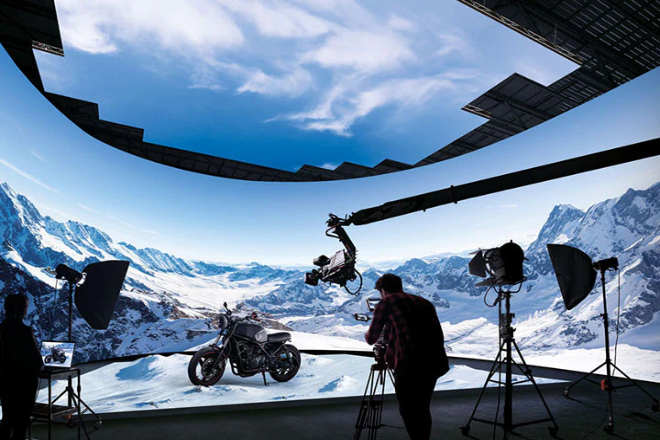
1) 높음 재생률
When shooting a movie, the refresh rate of the LED display screen is crucial.
Generally speaking, a refresh rate of 3840Hz can already meet most shooting needs, but for cinema film production, the refresh rate may need to reach 7680Hz or above.
A high refresh rate can effectively avoid problems such as stroboscopic and water ripples during shooting, ensuring the stability and clarity of the picture.
2) 높음 해결
High-resolution LED display screens can present more delicate picture effects. In virtual shooting, the smaller the screen’s dot pitch, the higher the picture quality.
Currently, virtual shooting mostly uses screens with a dot pitch of P2.6 or below.
3). Color reproduction
LED display screens need to have high color reproduction to present more realistic scenes.
In movie shooting, the larger the color gamut of the display screen, the better. Currently, the DCI-P3 color gamut range is a more mainstream choice.
In addition, the display screen also needs to have a high contrast ratio, such as an ultra-high contrast ratio of 8000:1, to ensure the color level and details of the picture.
4). Good 시야각
The viewing angle of the LED screen is required to meet the horizontal and vertical directions of at least 140 degrees, preferably more than 160 degrees.
The larger the viewing angle, the higher the freedom of the camera position, which can better adapt to the shooting needs of different angles.
5) 안정성 및 내구성
Various unexpected situations may occur during the filming process, so the LED display needs to have good stability and durability.
For example, the display needs to have a certain degree of moisture and dust resistance to adapt to the actual scene requirements, such as smoke on the scene.
6. 결론
The emergence of LED displays has brought unprecedented freedom and efficiency to filming.
It not only breaks through the limitations of the venue but also shows great advantages in cost control, artistic presentation, and environmental sustainability.
With the continuous advancement of technology, the application of LED displays in film production will be more extensive.
마지막으로 LED 디스플레이에 대해 더 알고 싶으시다면, 저희에게 연락주세요.
다음 내용에 관심이 있으실 수도 있습니다.
Other articles about virtual shooting of LED display screens:
